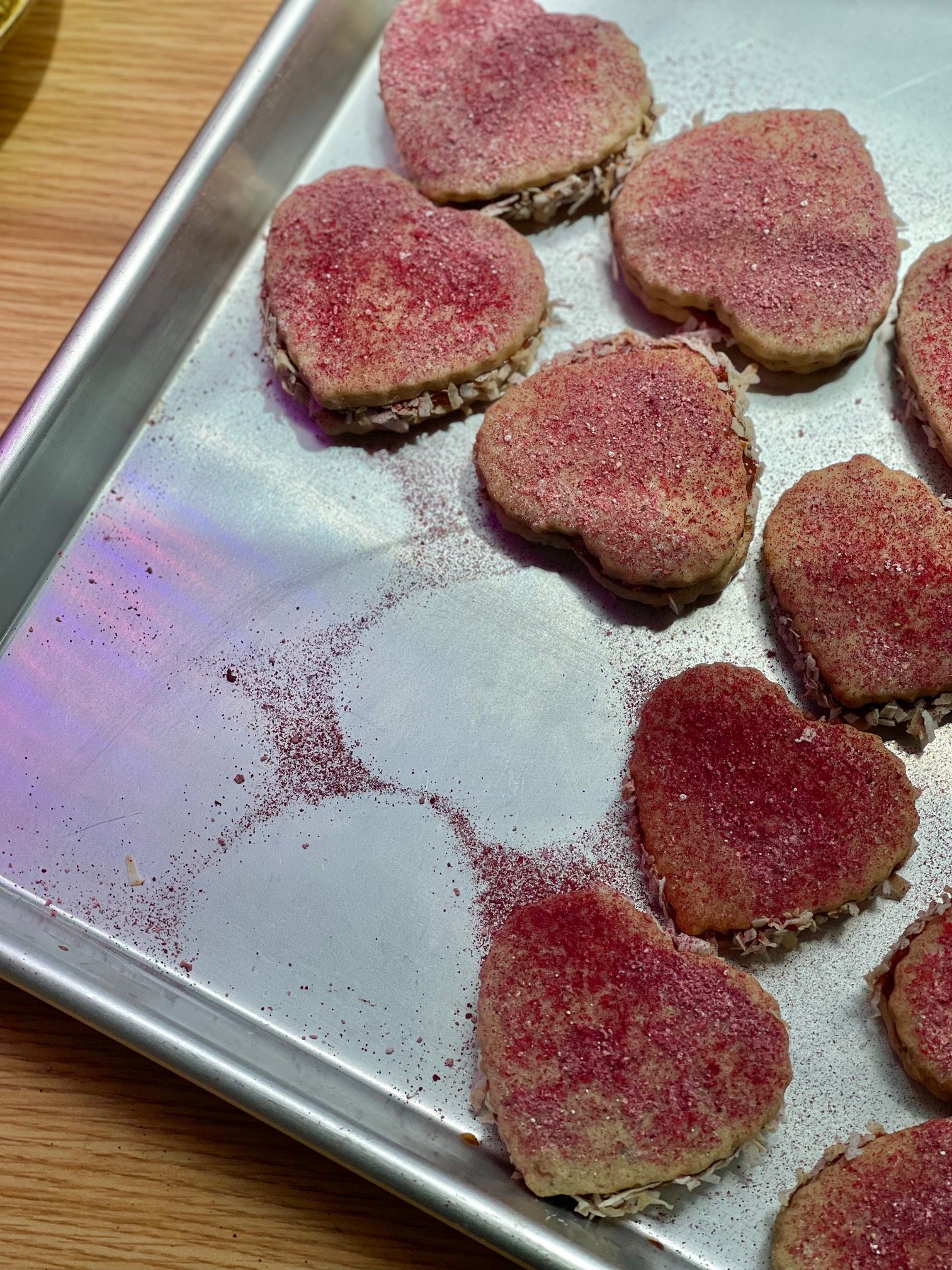Pecan Alfajores
My version of the classic South American cookie, the alfajor, gets toasted Georgia pecans in the dough and of course some pretty pink dusted on top. With nuts, these are technically alfajor de nuez (“of nuts”, in Spanish); I’ve seen this made most commonly with walnuts but Georgia has pecans so pecans it was. Toasting the pecans before grinding them down in a food processor is exactly how I start the recipe for the linzer cookies I used to make at my now dead in the ground, long gone online cookie business Milagro Kitchen. Lots of you here have eaten those cookies, and the fact that you’ve hung around with me for this chapter of my Cancer rising* come to life means so much.
This recipe replaces some of the flour in those Milagro Kitchen cookies with cornstarch, the one ingredient that makes an alfajor, an alfajor. The result is a crumbly, soft cookie that when paired with the dulce de leche is so pleasurable. I think the cornstarch contributes to these cookies not exactly brown in the oven when baking. Their bottoms or undersides do get a bit brown though, and that’s how you know they’re ready to be pulled from the oven. They’re also quite soft straight from the oven but will firm up more as they cool, so be mindful to not overbake them.
Use as much flour as needed to prevent sticking to your rolling pin and work surface. The longer the dough sits out, the stickier it will be, so it’s best to try and work fast. But also, again: there is no need to stress! If the dough is sticking to your rolling pin: sprinkle on a bit more flour. If the dough is cracking at the edges: cut out as many alfajores as you can from the center and just re-roll the dough scraps, sprinkling flour when needed. When I first started baking again about a decade ago after spending most of my 20s believing I was a shitty baker and attempted roll-out cookies, it was so stressful to me whenever the dough would crack. But I’ve made some variation of this exact recipe many, many times and I’m here to encourage you and tell you there’s no need to stress. You got it. It’s so easy.
ALFAJOR NOTES:
Swap out the pecans for whatever nut you’re feeling; almonds would be great in here, as would the more traditional walnuts.
The dark rum is optional; I would just up the amount of vanilla extract to a whole tablespoon if omitting the rum.
If your dough was chilling for 2 hours, it should be ready to roll in about 10-15 minutes. A longer chill time means the dough will need to sit out for longer; generally the dough should be ready to roll within 1-2 hours of sitting on your counter if it was in the fridge for a long while.
Use as much flour as you need when rolling out the dough to prevent sticking to both your rolling pin and work surface. This is a dough that really needs to be floured when rolling out, as it has a tendency to get quite sticky the longer it hangs out at room temperature.
Use a bench scraper or offset spatula to help transfer the alfajores to the baking sheet, if the dough is sticking to your surface.
When rolling, it's a good idea to give the dough a quarter turn after every couple of rolls. Again, to help prevent sticking.
These alfajores won’t brown on top the way cookies usually do when baked. Instead, look for the bottoms of the cookies to have just lightly browned. This is how you know the alfajores are done and ready to be removed from the oven.
The freeze dried raspberry for dusting the tops of each alfajor is optional; plain confectioner’s sugar works just fine.
The thinner you roll the dough, the more cookies you will get from this recipe. However, I really prefer alfajores to be quite thick so I roll to about ¼-inch thickness, which gives us a yield of about 21 alfajores, or 42 individual cookies.
I am using store-bought dulce de leche for this recipe for ease and convenience. If you’d like to make your own, this is a solid recipe from Arturo Enciso and Ana Belén Salatino of the beloved Gusto Bread in Long Beach, CA.
At Heart Panaderia Pecan Alfajores
Yield: ~21 alfajores (about 42 individual cookies), depending on how thick dough is rolled
100 grams (about ¾ cup) whole pecans
300 grams (2 ½ cups) all-purpose flour
66 grams (½ cup) cornstarch
½ teaspoon baking powder
½ teaspoon ground nutmeg
1 teaspoon kosher salt
8 ounces (2 sticks) unsalted butter, softened
110 grams (about ½ cup) granulated sugar
1 large egg
½ tablespoon dark rum
½ tablespoon vanilla extract
½ cup dulce de leche
⅓ cup coconut flakes
¼ cup freeze-dried raspberries, finely ground, optional
¼ cup confectioner’s sugar
Make the alfajores:
Preheat your oven to 350F. On a small rimmed baking sheet, spread pecans in a single layer. Toast pecans until fragrant, about 7-8 minutes. Transfer pecans to a small bowl and place the coconut flakes on the baking sheet. Toast coconut for 6 minutes, or until browned to your liking. Turn the oven off. In a small bowl whisk the finely ground freeze dried raspberry, if using, and the confectioner’s sugar.
In a medium mixing bowl, whisk together the flour, cornstarch, baking powder, ground nutmeg, and salt.
Using a food processor, pulverize the pecans until finely ground.
To the bowl of a stand mixer, cream the butter and sugar on medium speed until very light and fluffy, about 5 minutes. Scrape down the sides of the bowl with a rubber spatula as needed.
Crack in the egg and mix; add the dark rum and vanilla extract and continue mixing just for a minute or so. Add the finely ground pecans to the mixture now; mix just until everything is incorporated. With the mixer on its lowest setting, add the dry ingredients to the bowl. Mix until there are no dry pockets of flour. Divide the dough in half; wrap both halves with plastic and transfer to your fridge to chill for at least 2 hours or up to 24 hours.
Roll out the dough and bake alfajores:
Set both halves of the alfajor dough on your counter to soften a bit before rolling. The dough is ready to be rolled out when it feels soft but not overly sticky to the touch ( see ALFAJORE NOTES above).
Preheat your oven to 350F again. Line a half baking sheet with parchment paper.
On a floured work surface, roll out one half of the alfajor dough to about ¼-inch thickness. Using a 2-inch cookie cutter, cut out as many alfajores as possible. Place about 12 alfajores at a time on the prepared baking sheet and bake for 13-15 minutes, or until their undersides are lightly browned. Re-roll the dough scraps and repeat. Repeat until all dough scraps have been used up and baked.
Let alfajores cool on the baking sheet for 5 minutes, then transfer to a cooling rack. Alfajores should be cooled completely before attempting to assemble.
Assemble alfajores:
Flip half of the alfajores over and either pipe or spoon on about 1 ½ teaspoons dulce de leche. Place the remaining alfajores on top of each half and gently press to spread the dulce de leche just beyond the edges of the cookie so the coconut flakes have something to adhere to.
Roll the sides of each alfajor in the toasted coconut flakes and place back on the cooling rack. Lightly dust the tops of each alfajor with the raspberry confectioner’s sugar, if using, or with just plain confectioner’s sugar.
To store the alfajores:
Cookies will keep in an airtight container in your fridge for up to 5 days; alternatively, you can store them at room temperature for up to 3 days (if it is a particularly hot week, or your kitchen runs warm it is best to keep the alfajores chilled).




